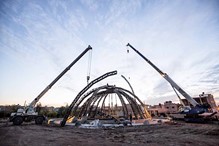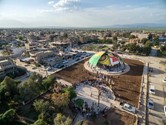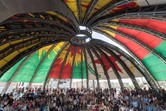[urban interfaces] Blogs
The Potential of Political Spaces
This blogpost is a result of the graduate seminar “Interfacing the (In)formal City” 2021.
Written by Floor Mijland.
The Potential of Political Spaces

Image 1: Parliament construction. Studie Jonas Staal, 2015.
The [Urban Interfaces] seminar of place March 18th,
titled ‘(In)formalizing the City: Commons, Agonisms, Interventions’, centred around the topic of ‘emerging citizen-centric and technology-enabled ways of re-configuring and re-engaging with current urban life’ (RMeS 2021). Together we focussed on the idea of ‘urban commons’, in the shape of goods, systems and practices. In this blogpost, I would like to focus on the ‘agonisms and interventions’, using a few snippets from this Stavros Stavrides’ book Common Spaces of Urban Emancipation (2019) and relating it the work of Dutch visual artist Jonas Staal, and his organisation ‘New World Summit’.
Space as Potential
In the first chapter of his book, Stavrides states immediately that he aims to establish “a rethinking of the possibility of human emancipation through a rethinking of space” (Stavrides 2019, 11). Space can be considered both as a concrete social reality, e.g. a house or public space, as well as a form or pattern. In this space, contested meanings of social reality are established: it concretises the relations between people, “by producing, enhancing, or destroying the visibility of acts, actors, objects (etc.)” (12). Hence, we should be very aware of the shaping effect of spaces, especially considering its potential power for emancipation. Or as Stavrides formulates it:
If emancipation has to do with social relations that are based on equality, justice, sharing, and solidarity, experiences in space, experiences shaped through existing spaces, may concretize such relations in the form of lived conditions (12).
Continuing his chapter, Stavrides beautifully analyses these ‘lived conditions’ in space.
Unfortunately, being the pragmatist that I am, I could not help but wonder: what do these spaces Stavrides writes about look like? Are there spaces that have actualised the emancipatory potential he sees in them? And how do these spaces concretise relations between people? To potentially serve as an answer, I would like to look at the work by Dutch visual artist Jonas Staal.
The New World Summit

Image 2: Parliament aerial view. Studio Jonas Staal, 2018.
In his artistic practice, Staal “deals with the relation between art, propaganda, and democracy” (Studio Jonas Staal 2005-2020 (1)), by creating spatial interventions and/or (art) installations. In 2012, Staal founded the artistic and political organization ‘New World Summit’. With this organization, Staal “develops parliaments with and for stateless states, autonomist groups, and blacklisted political organizations” (Studio Jonas Staal 2005-2020 (2)). The first edition of The New World Summit took place in northern Syria, as a commission by the autonomous government of Rojava:
In 2012, amidst the civil war in Syria, Kurdish revolutionaries, together with Assyrian, Arab, and other peoples of the region, declared the autonomy of Rojava. This resulted in the foundation of the Democratic Self-Administration of Rojava which practices a form of “stateless democracy” based on local self-governance, gender equality, and communal economy.
(Studio Jonas Staal 2005-2020 (2))
Though successfully declared as a state, Rojava still lacked a physical infrastructure to support their administration, diminishing their visibility through the lack of a shared space. To aid this problem, Staal was asked to design and construct a public parliament and an international summit in the region.
A Political Space
Staal came up with a circular design for the parliament building. The round shape emphasises the communal aspect of their politics, which is a cornerstone of their politics. Additionally, the arches that make up the dome carry key terms form the Rojava’s Social Contract, reminding all of the agreements they signed. Finally, the domes rooftop consists of fragments of local flags, from both social and political organisations.

Image 3: Parliament gathering. Studie Jonas Staal, 2018.
As such, the parliament is both a spatial manifesto of the Rojava Revolution, as well as a concrete space where its ideals are practiced on a day-to-day basis.
(Studio Jonas Staal 2005-2020 (2))
The architecture of the space, as designed by Staal, allowed the Rojava to practice their politics, successfully unlocking the potential of the space and earning it the name ‘People’s Parliament of Rojava’.
Potentiality
Answering my own questions, I think Staal’s parliament design shows what Stavrides seems to describe. Building on the title of his chapter, ‘Space as Potential’, the People’s Parliament of Rojava is exemplary for what potential space holds, and what the importance of such a common is for the emancipation of all parties involved. Very concretely, Staal made everyone equal through is circular design, yet allowing for the attention to be centred in the middle. Very concretely, the rhetoric of this space concretizes equality between people. To me, Staal’s spatial intervention makes tangible what Stavrides means when he states that “[s]patial arrangements interact with social experiences” (Stavrides 2019, 14). Staal used Rojava’s ideals to shape their parliament, and now it breathes these ideals back into their political practices.
Want to learn more about The New World Summit – Rojava? Check out this video: https://vimeo.com/144890359
Bibliography
Images
Image 1: Studio Jonas Staal. 2015. “Parliament construction”. Installation. Accessed March 20th, 2021. http://www.jonasstaal.nl/projects/new-world-summit-rojava/#&gid=null&pid=7.
Image 2: Studio Jonas Staal. 2018. “Parliament aerial view”. Installation. Accessed March 20th, 2021. http://www.jonasstaal.nl/projects/new-world-summit-rojava/#&gid=null&pid=1.
Image 2: Studio Jonas Staal. 2018. “Parliament gathering”. Digital photograph. Accessed March 20th, 2021. http://www.jonasstaal.nl/projects/new-world-summit-rojava/#&gid=null&pid=2.
Literature
RMeS. 2021. Urban Interfaces Seminar (2021): “‘(In)formalizing the City: Commons, Agonisms, Interventions”. March 18th, 2021.
Stavrides, Stavros. 2019. Chapter 1 “Space as Potential”. In Common Spaces of Urban Emancipation. Manchester: Manchester University Press.
Studio Jonas Staal. 2005-2020 (1). “About”. Accessed March 20th, 2021. http://www.jonasstaal.nl/about/
Studio Jonas Staal. 2005-2020 (2). “New World Summit Rojava”. Accessed March 20th, 2021. http://www.jonasstaal.nl/projects/new-world-summit-rojava/

